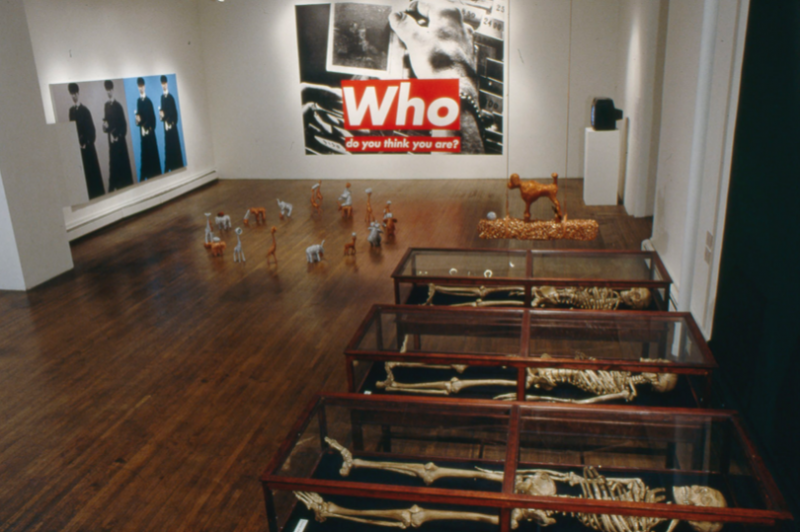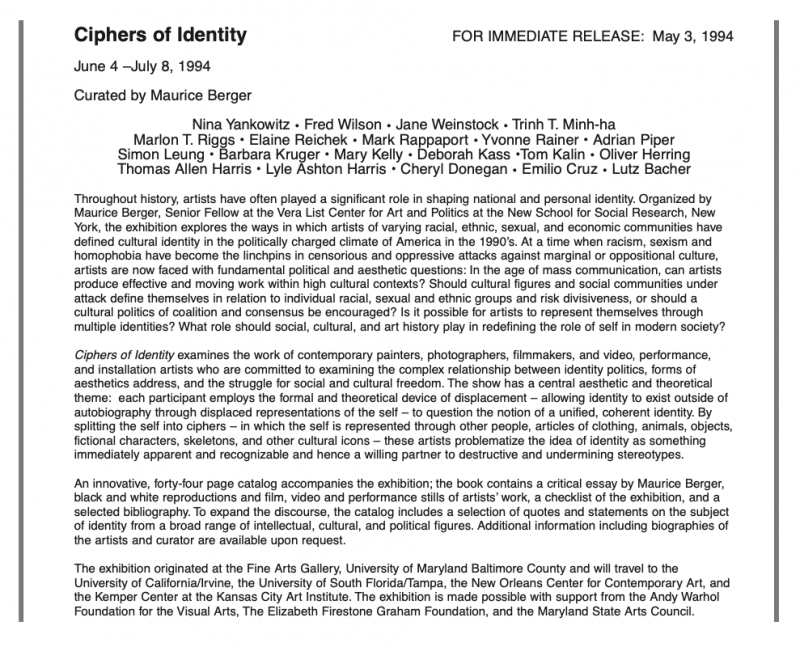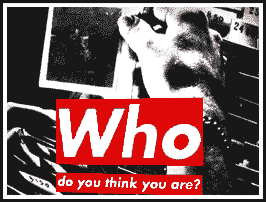Barbara Kruger ‘Who Do You Think You Are’ 1993
Barbara Kruger, Untitled, 1993. Private Collection.
Throughout history, artists have often played a significant role in shaping national and personal identity. Organized by Maurice Berger, Senior Fellow at the Vera List Center for Art and Politics at the New School for Social Research, New York, the exhibition explores the ways in which artists of varying racial, ethnic, sexual, and economic communities have defined cultural identity in the politically charged climate of America in the 1990’s. At a time when racism, sexism and homophobia have become the linchpins in censorious and oppressive attacks against marginal or oppositional culture, artists are now faced with fundamental political and aesthetic questions: In the age of mass communication, can artists produce effective and moving work within high cultural contexts? Should cultural figures and social communities under attack define themselves in relation to individual racial, sexual and ethnic groups and risk divisiveness, or should a cultural politics of coalition and consensus be encouraged? Is it possible for artists to represent themselves through multiple identities? What role should social, cultural, and art history play in redefining the role of self in modern society?
“““““““““““““““““““““““““““““““1992 Billboard project, Museu de Arte Contemporanea, Sao Paulo, Brazil
1992 Poster project, Magasin, Centre National d’Art Contemporain, Grenoble, France
1992 Cover, MS. MAGAZINE, January/February
1991 Op Ed page, THE NEW YORK TIMES, 4 June
1991 Cover, BOMB MAGAZINE, Spring
1991 Los Angeles Arts Park competition; project plan in collaboration with Smith-Miller & Hawkinson and Nicholas Quennell
1991 Billboard project, Von-der-Heydt-Museum, Wuppertal-Elberfeld, Germany
1991 Bus shelter posters, Public Art Fund, NYC
1990 Poster project, Warsaw
1990 Subway posters and electronic sign, Berlin
1990 Exterior wall project, Museum of Contemporary Art, Los Angeles, California
1990 Billboard project, Wexner Center for the Visual Arts, Columbus, Ohio
1990 Billboard and subway posters for Image World exhibition, Whitney Museum of American Art, NYC
1989 Seattle Signage Project, Pier 62/63, Seattle, Washington; collaboration with Smith-Miller & Hawkinson and Guy Nordenson
1989 Op Ed page, THE NEW YORK TIMES, 7 May
1989 Billboard project, Art Against AIDS, San Francisco
1989 Poster for March on Washington, DC for Women’s Reproductive Rights
1989 Billboard project, Public Art Fund, Manhattan and Queens, New York
1988 Picturing Greatness, exhibition curated and designed for The Museum of Modern Art, NYC, NY
1988 Billboard project, Adelaide and Melbourne, Australia
1988 Billboard project, Wellington, New Zealand
1986 Billboard project, Art Angel, London, England
1985 Billboard project, Film in the Cities, Minneapolis, Minnesota
EXHBITION:
Throughout history, artists have often played a significant role in shaping national and personal identity. Organized by Maurice Berger, Senior Fellow at the Vera List Center for Art and Politics at the New School for Social Research, New York, the exhibition explores the ways in which artists of varying racial, ethnic, sexual, and economic communities have defined cultural identity in the politically charged climate of America in the 1990’s.
At a time when racism, sexism and homophobia have become the linchpins in censorious and oppressive attacks against marginal or oppositional culture, artists are now faced with fundamental political and aesthetic questions: In the age of mass communication, can artists produce effective and moving work within high cultural contexts? Should cultural figures and social communities under attack define themselves in relation to individual racial, sexual and ethnic groups and risk divisiveness, or should a cultural politics of coalition and consensus be encouraged?
Is it possible for artists to represent themselves through multiple identities? What role should social, cultural, and art history play in redefining the role of self in modern society?







